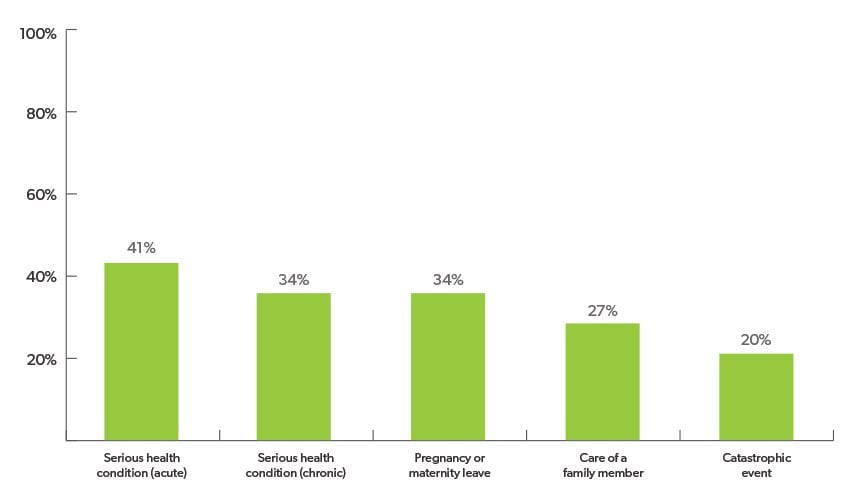
Typically, when the term FMLA comes up, most people (that is, anyone NOT employed in the field of Human Resources) immediately think of maternity leave. While FMLA obviously does kick in for maternity leave, according to ERC’s research, when it comes to administering FMLA, pregnancy/maternity leave is really the least of HR’s worries. Instead, for most HR practitioners, the challenge lies in the administration of FMLA for serious health conditions and/or other circumstances outside of pregnancy and child birth.
In addition, as the graph below illustrates, pregnancy/maternity leave actually only accounts for an average of one-third of all FMLA absences at organizations, tying it for second place with “serious health condition (chronic)” and coming in just behind “serious health condition (acute)” at 41%.
Average percentage of FMLA leave absences due to each of the following circumstances

Given that maternity leave is both fairly straight forward and relatively well understood in comparison to the other types of situations that qualify employees for leave under FMLA, let’s take a deeper look at some of the most common challenges that employers face when administering FMLA outside of maternity leave.
Insufficient Notice
Many companies set policies asking that employees provide a set number of days’ notice before taking FMLA leave based on the type of situation. However, aside from maternity leave, ERC’s data shows that on average, employees are falling far short of the “required” threshold listed in the company handbook.
Unfortunately, by their very nature the health conditions or family emergencies that are most likely to fit under FMLA are also the least predicable—even those babies can show up whenever they feel like it and throw a wrench into the otherwise predictable maternity leave.
As a result, employers (and HR specifically) often find themselves scrambling to make quick determination about the employee’s eligibility and whether or not the circumstances qualify under FMLA. Not to mention, how to still accomplish all of the employee’s job duties in their absence. However, it is critical to keep in mind that FMLA is in fact a federal law. So, regardless of in-house policies, if it is ultimately determined that the circumstance would qualify under FMLA, the leave must be allowed.
Does the condition/circumstance qualify?
I know I said we wouldn’t be focusing on maternity leave (besides, the answer to the question of “qualifying condition” is pretty obvious). But what about paternity leave upon the birth of a child or leave due to strict bed-rest during the pregnancy itself? The former, although extremely rarely used, is technically fair game under FMLA. As for complications during pregnancy that keep the mother from working, this simply initiates the 12 weeks of FMLA early and would require the mother to return to work sooner than 12 weeks following the birth.
When determining whether or not a serious health condition (either chronic or acute) “qualifies” the employee for leave under FMLA, ERC’s data indicates that the process often includes multiple steps.
Some organizations do rely on HR’s judgement and/or knowledge of the reason for leave at the outset of the process, but ultimately, virtually all organizations request an additional medical certification or documentation for verification.
Tracking
ERC has been collecting data on FMLA administration for almost a decade now, and “tracking” is consistently cited as the most common challenge faced by employers. More specifically, “tracking” for intermittent leave is their greatest challenge. Unlike maternity leave, when leave is able to be planned for a specific & continuous time period (admittedly, the exact dates can vary to a certain degree), tracking intermittent leave in an Excel spreadsheet (46% of the 2017 sample tracks FMLA using this method) is no small task.
In addition to the administrative burden that these unpredictable leaves of absence present to HR, over half of the employers in this year’s survey report receiving no notice from employees taking intermittent FMLA until the day on which the absence is going to occur.
As a result, a number of employers expressed concerns that one of two things were happening at their organizations: either they were not capturing all circumstances that could qualify for FMLA (leaving them open for legal repercussions down the line) or that employees were abusing their intermittent FMLA, i.e. claiming time off that isn’t actually related to their serious illness or the care of a family member.
Concurrent Benefits
The presence of, or lack of, concurrently offered benefits is really more of a challenge for the employee than for the employer. But, articulating how FMLA will interact with different leave of absence policies, time off offerings, and insurance benefits is a key piece of an employer’s handbook and can offer both guidance as well as legal protections if and when some of these more complex FMLA absences arise.
For example: Will your organization provide pay to individuals out on FMLA if their leave overlaps with a paid company-wide holiday?
Although the statue itself does not provide an answer one way or another (remember, FMLA only guarantees unpaid leave), HR and legal experts alike strongly suggest that your company handbook spells out the answer, just in case. Other options for receiving pay during FMLA leave are limited primarily by the amount of PTO (or vacation & sick time) accrued by the individual employee.
Although it is quite common for employers to require the use of PTO/vacation time during FMLA leave until the paid leave has been exhausted, employers should also be cognizant of their employee’s potential future need for time off not related to FMLA.
By requiring the full exhaustion of all paid time off, employers could risk potential conflicts in the future if additional time off has yet to be accrued (particularly if this is a top performing employee that you don’t want to lose). Instead, some employers may choose to leave their handbook language a bit more open-ended, using the phrase “may be required to exhaust”, just in case an employee wants to reserve some time off for future non-FMLA needs.
For longer term FMLA leaves, usually maternity, short-term disability often kicks in, but typically only for a portion of the remaining leave and at a fraction of the normal compensation (depending on the STD plan in place).
View ERC’s Family & Medical Leave Act Practices Survey Results
The survey reports Northeast Ohio organizations’ FMLA practices trends in FMLA administration, certification and notice, usage, and challenges.
